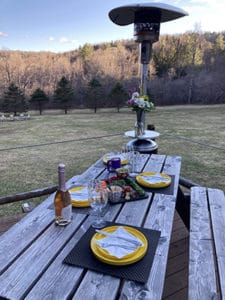By Merisa Sherman
I watch with a gleeful satisfaction as the wood greedily soaks up the stain. The pale color of the pine is overwhelmed by the darkness, like The Nothing taking over Fantasia in the “Never Ending Story.” It seeps across the grain like tentacles as I swipe my brush slowly along the wood. It’s beautiful, this creeping darkness, the dark walnut stain a stark contrast to the freshly sanded pine. The stain soaks up the brightness, penetrating deep into the wood and transforming it into something completely different. It’s almost like a magic trick, turning something from white to black with just a wave of my hand.

The picnic tables had needed refinishing. Badly. A couple of years of basking in the sunshine had started to weather the picnic tables and they were starting to look unloved. The dark stain had turned into a light gray and the fibers on the tabletop were beginning to get that fuzzy splitting look. It was time to get out the sander and slop on a fresh coat of stain. To make the old new again, to start fresh, to commit the effort to creating greatness.
It was a little bit different experience this time. The two plates of metal in my left arm vibrated like someone was tickling me from the inside. It was hilarious. Really. Well, okay, at first it was extremely disconcerting as the metal would continue to vibrate long after I stopped to take a break. I am now a tuning fork. Seriously — tuning forks are made with steel and my arm is stainless. It makes me laugh all the time, except when I’m shoveling snow and hit something. That sucks.
But how beautiful to watch the wood just consume the stain, like it was dying of thirst and only this will help it survive. Watching the wood soak up this external object, enthusiastically drawing the stain into its existence, I am feeding the wood, providing sustenance and nutrition. You can literally how grateful the wood is for this act of love. The pine is literally glowing, replete with that “just stepped out of a salon” feeling.
The work goes faster with friends. The time seems to fly by as you chat with your neighbors about this and that, letting the motions of the brush carry the rhythms of the conversation. Love is floating around us like a cloud and I am certain that it too, is being absorbed by the tables. You understand the someday soon, you will all be sitting around these tables, drinks in hand while you laugh together over some keg cooked chicken or lobsters.
These tables are our outdoor centerpiece, the heart of the backyard and now that we can, the place of gatherings with our friends and neighbors. Together we’ll sit and tell stories while the kids run around the yard. Someone will yell over from the fire pit and one of us we’ll have to get up and get something, but the table keeps us nimble, as you swing one leg up and over. But you’re drawn quickly back, nestling back into the coziness of the picnic table.
Because the picnic table seems timeless. A few easily cut pieces of lumber holding itself together in such a distinct yet beautifully simple pattern that has been a staple in the history of this country. The first table with attached seating was created by Charles H. Nielsen in 1903, an invention derived from the Victorian era’s enthusiasm for outdoor picnics and the lack of sturdy outdoor furniture. But it wasn’t until 1926 that Lassen National Forest created the first A-frame picnic table that we all know and love today. The “Lassen Table” became a staple in national parks and it was where members of the Civilian Conservation Corps would eat their meals.
They are classic pieces of Americana. My grandfather built the picnic table that we had growing up. It wasn’t a Lassen Table, but the memories are many, including coloring with my sister when we were very small. We would take the crayons and do rubbings of the wood grain to provide texture to our drawings. Even as kids we noticed the beauty of a simple wooden picnic table.
So now, with the help of friends, we are refinishing ours. I know which boards have beautiful bulls-eyes and which are still leaking sap even as I am covered in globs of dark stain. I’m not the neatest painter. It’s in my hair, it’s dripping down my leg and there’s a big blob on my foot. Nope, make that both feet. The tables are done but there’s still stain in my bucket. And so I start staining the bird houses but I run out of stain and have to refill. But now I have stain left over, so I start on the bird houses. I am trapped in a never ending staining project … so it goes.




